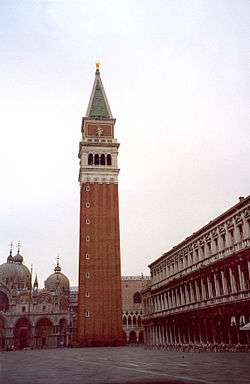Sather Tower
|
Sather Tower | |
|
Berkeley Landmark #158 | |
|
Sather Tower, from California Memorial Stadium, at sunset | |
| Location | Berkeley, California |
|---|---|
| Coordinates | 37°52′19″N 122°15′28″W / 37.87194°N 122.25778°WCoordinates: 37°52′19″N 122°15′28″W / 37.87194°N 122.25778°W |
| Built | 1914 |
| Architect | John Galen Howard |
| Architectural style | Gothic Revival |
| MPS | Berkeley, University of California MRA |
| NRHP Reference # | 82004650[1] |
| BERKL # | 158 |
| Significant dates | |
| Added to NRHP | March 25, 1982 |
| Designated BERKL | February 25, 1991[2] |
Sather Tower is a campanile (bell and clock tower) on the University of California, Berkeley campus. It is more commonly known as The Campanile (/kæmpəˈniːliː/ kamp-ə-NEE-lee) due to its resemblance to the Campanile di San Marco in Venice, and serves as UC Berkeley's most recognizable symbol. It was completed in 1914 and first opened to the public in 1917.[3] The tower stands 307 feet (93.6 m) tall, making it the third tallest bell and clock-tower in the world.[4] It was designed by John Galen Howard, founder of the Department of Architecture at the University, and it marks a secondary axis in his original Beaux-Arts campus plan. Since then, it has been a major point of orientation in almost every campus master plan. The tower has seven floors, with an observation deck on the eighth floor. Some floors are used to store fossils.
Overview

Sather Tower houses a full concert carillon, enlarged from the original 12-bell chime installed in October 1917 to 48 bells in 1979 and the current 61 bells in 1983. The original bells all bear the inscription "Gift of Jane K. Sather 1914," acknowledging the benefactress for whom the Tower is named. Jane was wife of the Norwegian-born banker Peder Sather. The largest of the original bells bears an inscription by Isaac Flagg, Professor of Greek, Emeritus, "We ring, we chime, we toll, / Lend ye the silent part / Some answer in the heart, / Some echo in the soul." The current bells range from small 19 pound bells to the 10,500 pound "Great Bear Bell," which tolls on the hour and features bas-relief carvings of bears as well as the constellation Ursa Major. During the Fall and Spring semesters, the carillon is performed for ten minutes at 7:50 a.m., noon, and 6:00 p.m. during weekdays, from 12:00-12:15 p.m. and 6:00-6:10 p.m. on Saturdays, and from 2:00-2:45 p.m. on Sundays. The bells also toll the hour 7 days a week between the hours of 8 a.m. and 10 p.m. At noon on the last day of instruction each semester, "They're Hanging Danny Deever in the Morning" is played. (The song employs only the original set of bells installed in 1917.) Following that, the carillon is silent until the end of finals.
A gift by Evelyn and Jerry Chambers in 1983 endowed the position of University Carillonist as well as practice rooms, practice keyboards, a campanology library, and international Carillon Festivals every five years from the anniversary of the Class of 1928. Private and group lessons are offered in carillon through the Department of Music, subject to auditions and with Music majors receiving priority. Students work on one of Sather Tower's two practice keyboards until they are ready to perform on the carillon itself.


An elevator takes visitors 200 feet up to an observation deck with sweeping views of the campus, the surrounding hills, San Francisco, and the Golden Gate. Admission is free for UC Berkeley students, staff, and faculty, two dollars for seniors, Cal Alumni Association members, and persons age 17 and under, and three dollars for everyone else.[5]
The trumpets of the California Marching Band every year play Cal spirit songs during Big Game week from the top of the tower. Known as the Campanile Concert, the music can be heard throughout the campus and Berkeley, and in some cases, all the way to Oakland.
Sather Tower also houses many of the Department of Integrative Biology's fossils (mainly from the La Brea Tar Pits) because its cool, dry interior is suited for their preservation.[6]
The surrounding promenade features a grid of pollarded London Plane trees, frequently enjoyed for the sport of slacklining.
In 1958 a 67-year-old retired attorney jumped to his death, prompting a daily patrol to guard the platform. In 1961, after an undergraduate suicide, glass was installed to enclose the viewing platform. These panes were removed in 1979 due to complaints that the panes were muffling the sound of the expanded carillon. In 1981 metal bars were installed.
Similar structures
A tower based on the Berkeley Campanile is located at the University of Concepción, Chile. Another university clock tower bearing a resemblance to the Campanile is the Joseph Chamberlain Memorial Clock Tower at the University of Birmingham, England, which is modelled on the Torre del Mangia in Siena.[7] David Lodge's novel Changing Places tells the story of exchange of professors between the universities of Rummidge and Euphoric State, Plotinus (thinly disguised fictional versions of Birmingham and Berkeley), which in the book both have replicas of the Leaning Tower of Pisa on campus.[8]
Footnotes
- ↑ National Park Service (2006-03-15). "National Register Information System". National Register of Historic Places. National Park Service.
- ↑ "Berkeley Landmarks". Berkeley Architectural Heritage Association. Retrieved 2013-03-04.
- ↑ "Architecture: A 'city of learning' overlooking SF Bay". History of UC Berkeley. Retrieved 2011-10-24.
- ↑ "The Campanile (Sather Tower)". UC Berkeley Visitory Services. Retrieved 2011-10-24.
- ↑ "The Campanile (Sather Tower) – UC Berkeley Visitor Services". Visitors.berkeley.edu. 2015-05-08. Retrieved 2015-05-14.
- ↑ "Geological Tour of UC – Berkeley: Sather Tower (the Campanile), in fog". Seismo.berkeley.edu. Retrieved 2015-05-14.
- ↑ Stephens, W.B. (1964). "Secular architecture". A History of the County of Warwick: Volume 7. London: Oxford University Press. pp. 43–57.
- ↑ Showalter, Elaine (2005). Faculty Towers: The Academic Novel and Its Discontents. Oxford: Oxford University Press. p. 77. ISBN 978-0-19-928332-3.
External links
| Wikimedia Commons has media related to Sather Tower. |
- Visitor Services – The Campanile at Berkeley
- Sather Tower Carillon (Music Dept. Page)
- The Campanile Movie
- Campanile Free-Fall
- Berkeley Landmarks :: Sather Tower

